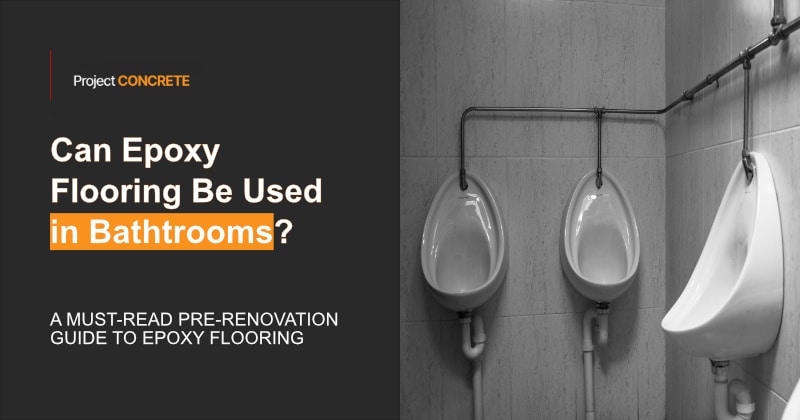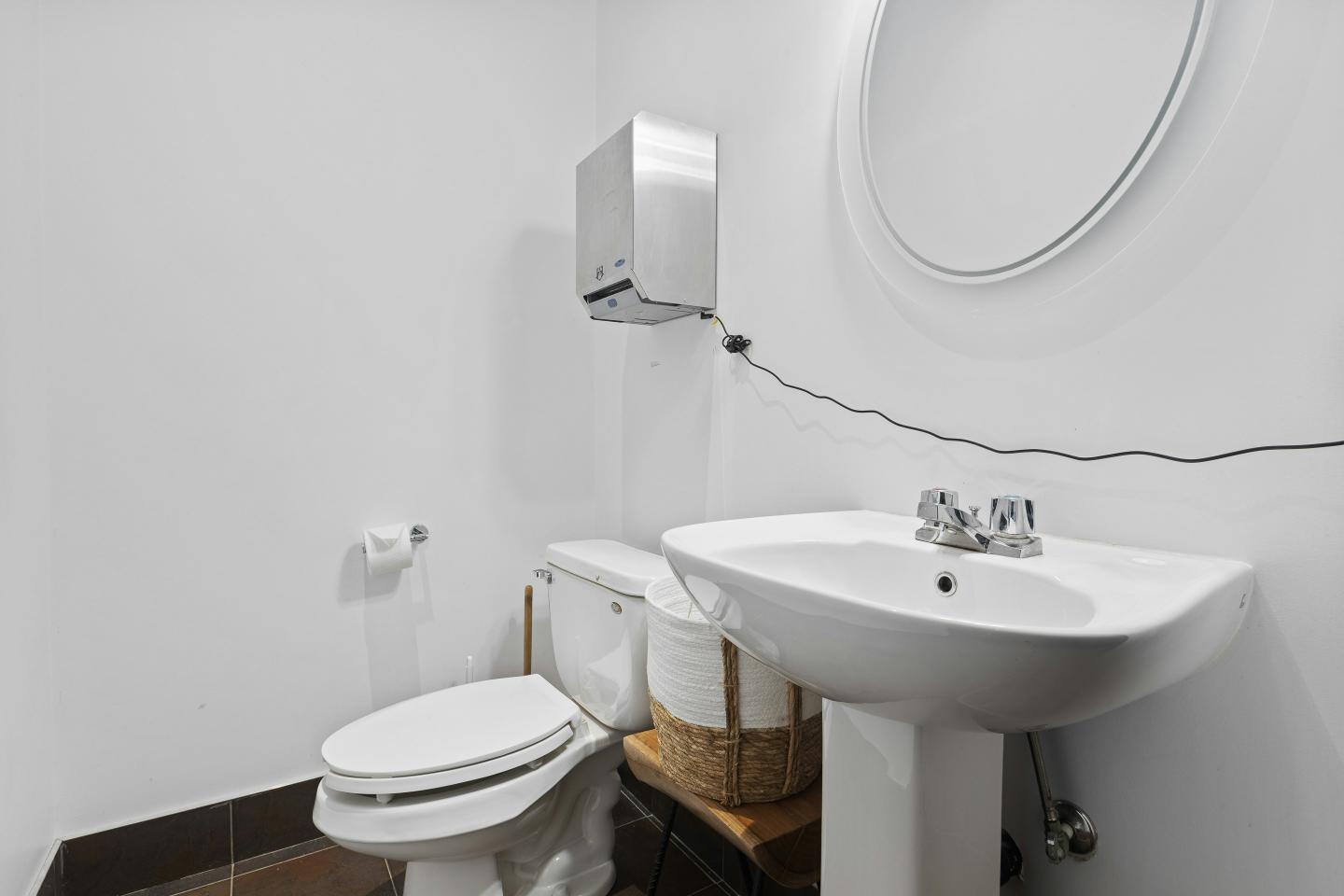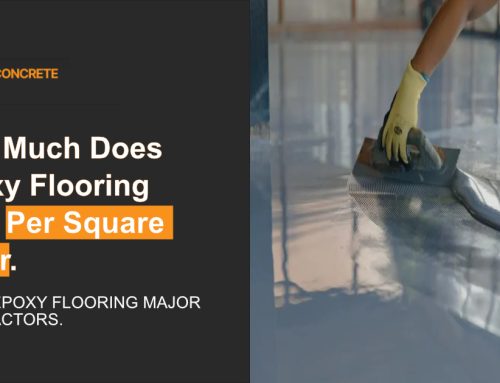
Epoxy flooring stands out as a robust and adaptable option, perfectly suited for enhancing both residential and commercial bathrooms. This innovative flooring solution, celebrated for its exceptional durability and aesthetic diversity, seamlessly marries functionality with style. As you contemplate a bathroom makeover or embark on creating a new one, diving deep into the realm of epoxy flooring will unveil its potential to revolutionise your space. From its unparalleled resistance to moisture and heavy wear to its vast array of design possibilities, epoxy flooring not only answers the practical demands of bathroom environments but also opens up a world of creative design opportunities.
What is epoxy flooring?
Epoxy flooring is a seamless, durable surface created by the application of a mixture consisting of resin and hardener onto a prepared floor base. This mixture undergoes a chemical reaction, forming a strong, rigid plastic material that adheres securely to its substrate. It is celebrated for its resilience, capable of enduring the demands of high traffic areas, which makes it a prime choice for a variety of environments, including the moisture-prone settings of bathrooms.

Its versatility doesn’t stop at durability; epoxy flooring also boasts a wide range of aesthetic options. From glossy solid colours to intricate 3D designs, it offers something for every taste, allowing for customisation that can match any decor. Most importantly, epoxy flooring is waterproof, a critical feature for bathroom environments where moisture resistance is paramount. This combination of practicality and aesthetic flexibility makes epoxy flooring an exceptionally suitable choice for both residential and commercial bathroom applications.
Can epoxy flooring be used in bathrooms?
Yes, epoxy flooring emerges as an exceptional choice for both residential and commercial bathroom settings. Its waterproof characteristics make it highly resilient against the omnipresent moisture in bathrooms, effectively preventing water damage. The surface of epoxy flooring is resistant to mold, mildew, and bacteria, which is crucial for maintaining a hygienic environment in such intimate spaces.
The durability of epoxy flooring is another significant advantage, as it can effortlessly withstand the heavy foot traffic commonly seen in commercial bathrooms, without compromising on appearance or functionality. Additionally, the ease of maintenance, requiring only simple cleaning methods, underscores its practicality, making it an attractive option for those seeking a blend of efficiency and aesthetic appeal in bathroom flooring. With careful attention to slip resistance and professional installation, epoxy flooring can transform any bathroom into a space that is both visually appealing and functionally superior.
Yes, Suitable for Residential and Commercial Bathrooms
Epoxy flooring stands out as an excellent choice for both residential and commercial bathrooms. Its waterproof properties ensure it can effortlessly handle the high moisture levels typical in these environments, thereby preventing any potential water damage. Moreover, its inherent resistance to mold, mildew, and bacteria underscores its suitability for maintaining hygienic conditions, which is paramount in both home and public restrooms. The durability of epoxy flooring, capable of withstanding extensive foot traffic, further reinforces its appropriateness for commercial applications where longevity and minimal maintenance are essential.
Why choose epoxy flooring for bathrooms?
Choosing epoxy flooring for bathrooms brings forth a myriad of benefits, positioning it as a top-tier choice for enhancing both residential and commercial spaces. Its waterproof capabilities stand at the forefront, offering unmatched defens
ce against water damage—a prevalent issue in bathroom settings. Furthermore, the resistance to mold, mildew, and bacteria that epoxy flooring exhibits ensures a clean and hygienic surface, crucial for any bathroom environment.

The durability of epoxy floors is another compelling reason for their selection, as they are designed to endure heavy foot traffic with ease, making them especially advantageous for commercial bathrooms. Additionally, the ease of maintenance associated with epoxy flooring—requiring nothing more than routine cleaning—significantly reduces the time and effort needed for its upkeep. These attributes collectively underscore why epoxy flooring is an attractive, practical choice for those seeking a durable, hygienic, and low-maintenance flooring solution for bathroom spaces.
Waterproof, Preventing Water Damage
Epoxy flooring offers an impermeable barrier against moisture, crucial for bathrooms where water exposure is frequent. This waterproof quality not only prevents unsightly damage but also protects the structural integrity of the floor.
Resistant to Mold, Mildew, and Bacteria
The seamless and non-porous nature of epoxy flooring creates an environment where mold, mildew, and bacteria struggle to take hold. This resistance is essential for maintaining a clean and healthy bathroom environment, free from harmful microbes.
Durable, Withstands Heavy Foot Traffic
Epoxy flooring is synonymous with durability. It is engineered to resist wear and tear, making it capable of withstanding heavy foot traffic. This resilience is particularly beneficial in commercial bathrooms, ensuring the floor remains intact and functional over time.
Easy to Clean, Requiring Minimal Maintenance
The ease of maintenance associated with epoxy flooring is a significant advantage. Its smooth surface allows for quick cleaning, needing only routine sweeping and mopping. This low-maintenance aspect makes it an ideal choice for both residential and commercial bathrooms, where efficiency and cleanliness are paramount.
Considerations for Epoxy in Bathrooms
When selecting epoxy flooring for bathrooms, it’s essential to weigh several critical considerations to ensure its effectiveness and safety. Slip resistance stands out as a top priority; due to the inherently wet conditions of bathrooms, opting for an epoxy coating that incorporates anti-slip features is vital for preventing falls and injuries.
Professional installation is another key factor to consider. Employing the expertise of professionals can make a significant difference in the outcome, ensuring that the epoxy adheres properly to the floor and is applied evenly, without any imperfections that could affect its longevity or appearance.
Lastly, cost comparison with alternative flooring options like tiles or vinyl should not be overlooked. Although epoxy flooring may present a higher initial investment, its durability and minimal maintenance requirements could lead to cost savings over time. These considerations are crucial for anyone looking to maximise the functional and aesthetic benefits of epoxy flooring in their bathroom.
Ensuring Slip Resistance for Safety
Emphasising slip resistance is essential in the wet conditions of bathrooms. Incorporating textured finishes or specific anti-slip additives into the epoxy can dramatically improve safety, minimising the risk of slips and ensuring a safer environment for all users.
| Anti-Slip Feature | Description | Benefits |
|---|---|---|
| Textured Finishes | A method of creating a slightly rough surface on the epoxy flooring to enhance grip. | Reduces the risk of slipping, especially when wet. |
| Anti-Slip Additives | Materials such as quartz sand or polymer beads mixed into the epoxy before application. | Provides additional traction underfoot, improving safety. |
Professional Installation for Best Results
Securing professional installation is key to unlocking the full potential of epoxy flooring. Skilled professionals ensure a flawless application, resulting in a durable and visually appealing surface that stands the test of time without succumbing to common flooring issues.
| Factor | DIY Installation | Professional Installation |
|---|---|---|
| Quality | May vary based on skill and experience. | High, due to expertise and specialised tools. |
| Time | Longer, learning curve and manual application. | Shorter, professionals work efficiently. |
| Outcome | Potential for errors and imperfections. | Smooth, even, and aesthetically pleasing finish. |
Comparing Costs with Tiles or Vinyl
Comparing costs with alternative flooring options such as tiles or vinyl is a crucial consideration. Although epoxy flooring may present a higher upfront cost, its exceptional durability and ease of maintenance often translate to cost savings in the long run, making it a worthwhile investment.
| Flooring Type | Initial Cost | Maintenance Cost | Durability |
|---|---|---|---|
| Epoxy Flooring | High | Low | Very High |
| Tiles | Medium | Medium | High |
| Vinyl | Low | High | Medium |
Installation Process of Epoxy Flooring
The installation of epoxy flooring is a meticulous process that commences with surface preparation, a critical step that involves cleaning, drying, and leveling the floor. This preparation is essential for ensuring a strong bond between the epoxy and the substrate. Next, the epoxy resin is mixed with a hardener, starting a chemical reaction that transforms the liquid mixture into a solid, durable surface. This mixture must then be evenly applied across the prepared floor, a task that demands precision to achieve a smooth, uniform finish.
The curing time for epoxy flooring varies, generally spanning from 24 to 72 hours. During this period, the floor should remain untouched to allow the epoxy to properly set and harden. When executed with care, this process yields a resilient and aesthetically pleasing epoxy floor, significantly enhancing the space’s functionality and visual appeal.
Detailed Installation Process and Considerations
| Step | Process | Common Challenges | Solutions |
|---|---|---|---|
| Surface Preparation | Cleaning, drying, and floor levelling. | Presence of cracks, imperfections, or moisture in the substrate. | Fill cracks with an appropriate filler. Ensure the floor is completely dry and level before proceeding. Use a moisture meter to check. |
| Mixing Epoxy Resin with Hardener | Combining the resin and hardener to start the chemical reaction. | Incorrect mixing ratios leading to improper curing. | Follow manufacturer’s instructions precisely for the ratio. Mix thoroughly to ensure a consistent blend. |
| Applying Epoxy Evenly Across the Floor | Spreading the mixture across the prepared floor for a uniform finish. | Bubbles, streaks, or uneven thickness. | Use a notched squeegee for even application. Remove bubbles with a spiked roller. Apply in optimal temperature conditions as recommended. |
| Curing Time | Allowing the epoxy to set and harden, typically 24-72 hours. | Premature exposure to traffic or moisture. | Clearly mark the area to prevent foot traffic. Check weather conditions to avoid humidity affecting the curing process. |
Design Options for Epoxy Bathroom Floors
Epoxy flooring brings a wealth of design options to the table, offering unparalleled versatility for bathroom floors. Options range from solid colours, perfect for achieving a clean, minimalist look, to metallic finishes that introduce a touch of modern sophistication. For those aiming to make a bold statement, 3D designs present an opportunity to embed dramatic, custom visuals directly into the flooring, turning the bathroom floor into a captivating focal point.
Additionally, the use of clear epoxy allows for the encapsulation of decorative items or images, offering a unique way to personalise the space. This adaptability in design choices means that whether you’re looking for something understated or eye-catching, epoxy flooring can be customised to meet any aesthetic, creating bathroom floors that are not only functional but also visually stunning.
Design Options and Considerations
| Design Option | Description | Considerations for Bathroom Decor |
|---|---|---|
| Solid Colours | A single, uniform colour applied across the floor. | Choose colours that complement the wall colours and fixtures. Lighter colours can make small bathrooms appear larger. |
| Metallic Finishes | Epoxy with metallic pigments that create a glossy, reflective surface. | Works well in modern or industrial-themed bathrooms. Can add a luxurious feel to the space. |
| 3D Designs | Custom, three-dimensional visuals embedded beneath the clear epoxy. | Ideal for creating a focal point. Consider the overall theme of your bathroom to ensure cohesion. |
| Clear Epoxy Over Decorative Items | Clear epoxy applied over items like coins, photos, or small objects. | Personalise your bathroom floor with items that mean something to you or match the bathroom’s theme. |
Current Trends and Tips for Choosing a Design
- Nature-Inspired Themes: Incorporating elements like pebbles or leaves under clear epoxy for a natural look.
- Geometric Patterns: Using stencils to create geometric patterns before applying the final epoxy coat for a contemporary design.
- Glow-in-the-Dark Epoxy: Adding glow-in-the-dark pigments for a unique nighttime effect.
- Colour Matching: Match or contrast epoxy floor colours with wall tiles or bathroom accessories for a cohesive design.
Tips for Choosing a Design:
- Consider the Size of Your Bathroom: Lighter colours and simple patterns can make a small bathroom feel larger.
- Think About Maintenance: Some designs may require more upkeep to keep them looking their best.
- Reflect Your Style: Choose a design that reflects your personal style and complements the overall aesthetic of your home.
- Consult with a Professional: Discussing your ideas with a professional installer can provide insights into what’s possible and what might work best for your space.
By considering these design options and trends, you can select an epoxy flooring design that not only enhances the functionality of your bathroom but also elevates its aesthetic appeal, making it a truly personalised space.
Maintenance of Epoxy Bathroom Floors
Maintaining epoxy bathroom floors is a straightforward process, emphasising the practicality of this flooring option. Routine cleaning with mild detergents effectively keeps the floor clean and preserves its glossy appearance. It’s crucial to steer clear of harsh chemicals, which can compromise the integrity of the epoxy surface. Over time, to maintain the floor’s resilience and shine, periodic resealing may be required. This minimal maintenance ensures that epoxy bathroom floors continue to serve both functional and aesthetic purposes efficiently, making them an enduringly attractive choice for bathroom flooring.
Detailed Maintenance Guide
| Maintenance Task | Recommended Products | Step-by-Step Guide |
|---|---|---|
| Regular Cleaning | Mild detergent or pH-neutral cleaner | 1. Sweep the floor to remove loose dirt and debris. 2. Mix the mild detergent with water according to the product instructions. 3. Mop the floor with the detergent solution, using a soft mop. 4. Rinse the mop and go over the floor with clean water to remove any soap residue. 5. Allow the floor to air dry or use a soft, clean towel to dry the floor. |
| Removing Stains | Isopropyl alcohol (for tough stains) | 1. For regular stains, use the mild detergent solution and let it sit on the stain for a few minutes before mopping. 2. For tougher stains, apply a small amount of isopropyl alcohol to a clean cloth and gently rub the stain. 3. Clean the area with the detergent solution to remove any alcohol residue. 4. Rinse with clean water and dry. |
| Periodic Deep Cleaning | Commercial epoxy floor cleaner | 1. Remove all items from the floor. 2. Sweep and mop the floor with a mild detergent solution to remove initial dirt. 3. Apply the commercial epoxy floor cleaner according to the manufacturer’s instructions. 4. Use a soft-bristled brush or mop to scrub the floor gently. 5. Rinse the floor thoroughly with clean water. 6. Dry the floor with a soft towel or allow it to air dry. |
| Periodic Resealing | Epoxy floor sealant | 1. Consult with a professional to determine if your floor needs resealing, as this depends on foot traffic and wear. 2. Ensure the floor is clean and completely dry before resealing. 3. Apply the epoxy sealant according to the manufacturer’s instructions, using a roller or brush. 4. Allow the sealant to cure for the time specified by the product, usually 24-72 hours. 5. Avoid foot traffic on the floor until the sealant has fully cured. |
Tips for Maintaining Epoxy Bathroom Floors
- Avoid Harsh Chemicals: Harsh chemicals can damage the epoxy coating. Always opt for mild detergents or cleaners specifically designed for epoxy floors.
- Use Soft Cleaning Tools: Soft mops and cloths are ideal for cleaning epoxy floors to avoid scratching the surface.
- Attend to Spills Promptly: Clean up spills as soon as they occur to prevent staining and slipping hazards.
- Protect Against Scratches: Place mats at entrances and consider using rugs in high-traffic areas to minimise wear and tear.
- Regular Inspection: Periodically inspect your floor for any signs of wear or damage, such as scratches or peeling, and address these issues promptly to maintain the floor’s integrity and appearance.
Environmental Considerations of Epoxy Flooring
Epoxy flooring, while celebrated for its durability and aesthetic appeal, also brings to the forefront important environmental considerations. Its longevity stands as a testament to sustainability, significantly reducing the frequency of replacements and, consequently, the generation of waste. The option for low VOC (Volatile Organic Compounds) formulations underscores epoxy flooring as a healthier choice for indoor spaces, aiming to minimise the release of harmful chemicals into the environment. Nonetheless, ensuring proper ventilation during the application process is crucial to mitigate any potential short-term fume emissions. Opting for epoxy flooring thus represents not only a decision for a durable and visually pleasing surface but also a step towards a more environmentally conscious selection.
Epoxy is a Long-lasting, Sustainable Option
Epoxy flooring stands out for its remarkable durability, positioning it as a sustainable flooring solution. Its ability to withstand years of use not only ensures longevity but also supports environmental sustainability by reducing the frequency of flooring replacements and minimising waste.
Low VOC Options are Available
Acknowledging the growing concern for environmental health, low VOC (Volatile Organic Compounds) options for epoxy flooring have been developed. These alternatives greatly lower the emission of harmful chemicals, aligning with healthier living spaces and a reduced environmental footprint.
Proper Ventilation Required During Installation
To ensure a safe and comfortable environment during the application of epoxy flooring, adequate ventilation is crucial. This measure is essential to dissipate any fumes quickly, safeguarding the well-being of both the installation team and the premises’ occupants.
Jonathan Blackburn
March 10, 2024

















Social Media